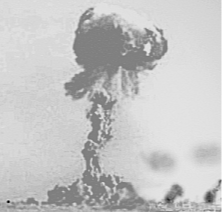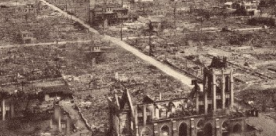December 19th, 1949
In Iberia the fighting has diminished as Alliance forces consolidate their gains, bring in additional forces, and work on improving their logistical lines of supply in the face of increasing German ballistic missile strikes on Portugeuesse port cities, including a growing use of nerve gas. Axis forces, still thinly stretched for such a broad front, have pulled back to more defensible lines in central and southern spain while dramatically increasing anti-aircraft defenses in the face of growing Alliance air superiority. Alliance air forces continue to pound Iberian logistical hubs and Axis troop concentrations while Alliance fighters have begun to range further East in an effort to draw out the Luftwaffe.
Meanwhile, while small Axis forces dig in for a rear guard defense in Algeria and Libya the first waves of transports have begun to ferry Axis forces to Sicily and other islands across the central Mediteranean; the Axis withdrawal from North Africa is underway.
December 21st, 1949
German forces in northern Russia have captured the entire southern shore of Lake Ladoga and are approaching Tikhvin but have been slowed to a crawl by Soviet resistance and, more importantly, worsening Winter conditions. Leningrad itself remains under siege but defiant, beating back multiple German attempts to break into the final ring of defenses in the city outskirts.
To the south one German mechanized princer has bypassed Kalinin and torn though weak Soviet forces to reach the Volga River due north of Moscow. However, a frustrated German high command is forced to call for an operational pause as the panzers have outrun their logistical tail and German fuel reserves are beginning to get critically low with the Baku oil fields wiped out.
Further south the situation is similar; another German mechanized pincer has pushed northeast from Tula and is now actually southeast of Moscow. There is now a clear potential for the Germans to complete a massive operational encirclement of Moscow and the 600,000 Soviet soldiers on that entire front. However, German mechanized forces are exhausted, critically low on fuel, spare parts, and mired in deepening snow.
In southern Russia the picture is different. The German advance has been relatively easy due to the massive Red Army mutiny and collapse of Soviet morale in the region since the final fall of Kiev. However, the relative lack of wear and tear is mostly offset by an incredibly long logistical tail stretching across the scorched earth wasteland from the developing front at the Volga to German rail heads in western Ukraine.
The Soviets have managed to trade land for time and have by now largely crushed the mutiny or forced the diehard rebels to flee across German lines. They have also used the time to establish modest but effective defenses west of Beriagrad and all along the Volga. German and minor Axis forces have reached the Volga north and south of Beriagrad but have not attempted to approach Beriagrad as of yet.
In the air over Russia the Germans now have complete air superiority as the remnants of the Red Airforce regroup and lick their wounds in air bases close to the Urals or East of the Caspian Sea. German bombers, opposed only by outdated Soviet flak defenses, continue to reign hell on Soviet cities, transportation hubs, and industrial sites. Only the winter is preventing Luftwaffe tactical fighters and bombers from sweeping away the last Soviet armored formations.
The remnants of the Soviet spy network inside Germany have informed Beria that the German High Command has called a halt to offensive operations in the region until the Spring and Beria and Stavka are content to continue to build up defenses along the Volga and focus on the dire situation around Moscow.
December 25th, 1949
The Luftwaffe launches its first ever atomic attack on Christmas morning.
Starting at 7:00 AM London time over 100 medium jet bombers sweep in at dangerously low altitude to strike British radar sites all over southern Britain and the East coast of the British Isles with radar-seeking glide bombs and missiles. German destroyers add their weight to the attack, coming in close to Britain’s East coast at points to launch their own anti-radar missiles at coastal radar facilities. The coordinated attack results in nearly two dozen jet bombers downed and three destroyers sunk but wreaks havoc on Britain’s combined radar air-defense system.
Coming in at much higher altitude behind multiple, massive, drifting walls of chaff and ECM from German ARP(airborne radar platform) aircraft is most of the combined strength of the Luftwaffe’s remaining heavy bomber force escorted by a surge of nearly 400 Luftwaffe fighters of all types.
Highest above the fray are 24 German Ju-598 heavy bombers divided into two groups of twelve and approaching Britain behind the escorting fighters and above the roughly one hundred older-model Ural and Ju-588 heavy bombers. The two distinct groups of Ju-598’s,an upgraded version of the Ju-588 with more powerful turboprop engines and more defensive armaments, are headed towards the two targets selected by Hitler and the German High Command : London and Liverpool. Within each group of Ju-598’s one bomber carries Germany’s first atomic bomb model, a first-generation implosion device.
A swarm of nearly 500 British and American fighters, over half of them jets, rises to meet the German attack, vectored in by the degraded but still functioning British air defense system that is being supplemented by American ARP aircraft. As a massive chaotic series of dogfights erupts over southern Britain German heavy bombers begin their approaches on London and Liverpool. In all the Germans will lose 25% of all the heavy bombers, including 6 of the 24 Ju-598’s, to enemy fighters and ground fire. Unfortunately for the British the German atomic bombers are not among those losses.
At 8:32 AM London time the first German atomic bomb detonates some 800 feet in the air over Bedford Square, nearly a kilometer north of the intended target of Westminster. None-the-less, exploding with a power of 21 kilotons the atomic bomb destroys most of downtown London outright and ignites firestorms which sweep through the north of the city center to ultimately kill over 100,000 people from the firestorms themselves and the radioactive fallout. British Prime Minister Alec Douglas-Home, taking breakfast in his bunker complex beneath Westminster, survives the attack thanks to the atom bomb being off target though it takes nearly a day before crews digging through the rubble of Westminster reach the bunker.
At 9:14 AM local time the second German atomic bomb, this one achieving 22 kilotons, explodes on target over the port of Liverpool. Over a dozen Royal Navy vessels and more merchant ships are destroyed entirely or sunk while the port complex itself and associated wharves, warehouses, and harbor infrastructure are all destroyed entirely or very heavily damaged. The port is swollen with navy sailors, merchant marine, port and dock workers, and warehouse labor working to process the vital incoming flow of American and international arms and supplies. They have had plenty of warning of the incoming raid and are hunkered down in bomb shelters for the most part. They have experienced many raids like this before. But this is a different kind of attack and there hasn’t been time to warn them about the atomic strike in London. The atomic detonation over the port of Liverpool kills nearly 50,000 workers and sailors, effectively the entire workforce on shift, instantly and nearly that many civilians from firestorms and fallout in neighboring districts.
It takes several hours for the BBC to announce confirmation of the atomic attack, broadcasting from an alternate facility north of London after being off the air for over an hour. Over the coming days the British will begin to call the surprise dual atomic attack “Black Christmas”. The atomic attacks, combined with nerve gas bombing from the mass of German heavy bombers, devastate central London and the port of Liverpool, effectively wiping them out and ultimately killing over 300,000 as nerve gas and radiation sickness will continue to claim lives for some time .
The German attack force, for its part, suffers extremely high attrition. In addition to nearly 25% of the heavy bomber force the Germans also lost over 90 jet and late-model prop fighters. The fighter airframes themselves can easily be replaced by Germany’s churning aviation factories but the loss of trained pilots is a much greater blow.
Mushroom cloud over Liverpool following detonation of 22 kiloton atomic bomb over the city’s port district

Part of Central London a week after the “Black Christmas” atomic strike

December 26th, 1949
As the Alliance reels from the news of the twin German atomic strikes on Britain the Germans quietly put out feelers for ceasefire talks with the Soviet Union via back channel contacts in Switzerland. The Soviet response is swift : they will accept talks though there will be no immediate ceasefire.








Very good work but it would be cool for people like me to get to see some pictures/descriptions of any new tanks, aircraft ect